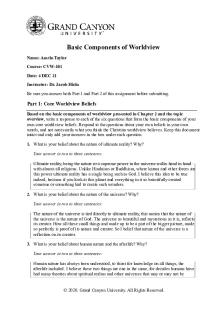Components of Goals and Expected Outcomes PDF

| Title | Components of Goals and Expected Outcomes |
|---|---|
| Course | Fundamentals of Nursing |
| Institution | Eastern Florida State College |
| Pages | 2 |
| File Size | 38.7 KB |
| File Type | |
| Total Downloads | 60 |
| Total Views | 151 |
Summary
In Person - Melbourne Campus...
Description
Components of Goals and Expected Outcomes
There are five components of well-constructed goals and expected outcomes: subject, task statement, criteria, conditions, and time frame. An in-depth discussion of each component of an appropriately written goal follows. For clarity of each concept, examples are provided. Subject The component to be considered initially in writing a goal is the subject. The subject identifies the person who will perform the desired behavior or meet the goal. In a clientcentered plan of nursing care, the client is the person who needs to achieve a desired change in behavior. Task Statement The next component in writing goals is the task statement or the action verb. This component describes what the client will do to achieve the expected change in behavior. The task statement enables the evaluator to determine achievement of the observable behavior. When the actual behavior is stated as a task statement that can be clearly and directly measured, the nurse can determine whether the client is demonstrating achievement of the goal. Only one task statement should be used for each goal. Criteria The next essential component is the criteria of a goal. Criteria are standards used to evaluate whether the behavior demonstrated indicates accomplishment of the goal. The nurse should specify the precise performance to be considered acceptable in accomplishment of the goal. It is not always possible to specify a criterion with as much detail as one would like; however, the nurse should continue to communicate precise criteria as explicitly as possible. Conditions The next component to be included in writing effective goals is the conditions under which the client should perform or demonstrate mastery of the task. Although this component is optional in terms of writing goals, conditions may provide clarity and assist the client to demonstrate the
expected behavior. Time Frame The last component to be included in writing goals appropriately is the time frame in which the client should perform or demonstrate mastery of the task. ENCOUNTERED IN PLANNING Planning care is a complex process. Nursing students, as beginners in the use of the nursing process, often fall into some common pitfalls when applying the process to practice. These pitfalls are described with the intent of providing a clear direction for the use of this process and proposing suggestions for avoiding common errors. In regard to writing goals, errors frequently observed in this component involve improper format. Format errors include goals that are nurse centered instead of client centered, unrealistic, negative rather than positive, generically copied from a reference and not individualized to the client, unmeasurable, nonspecific, nonbehavioral, vague, wordy, and lacking a time frame. Another challenge in the development of goals and expected outcomes is the establishment of appropriate time frames for accomplishment of the intended results. Although this component may be difficult at first to master, nursing students should practice writing goals that are realistic and include appropriate time frames using available literature and resources to gain expertise. It is preferable for a goal to include an excessively short, rather than an excessively long, time frame because the goal is brought to attention in the evaluation process more frequently. By inserting the time frame ‘‘daily’’ for specific goals, the expected outcome will be brought up frequently for evaluation....
Similar Free PDFs

Outcomes of Disciplinary Hearing
- 2 Pages

Components of a Product
- 5 Pages

Components of a Microcomputer
- 4 Pages

Components of Social Casework
- 8 Pages

Components OF Language
- 4 Pages

Components of ER Diagram
- 5 Pages

Goals of Sexology Notes
- 3 Pages

Goals of Punishment Worksheet
- 4 Pages

TVOM Concept and Components
- 14 Pages

3 Components of Attitude
- 13 Pages

Components OF Normal Hemostasis
- 5 Pages

Components of Ecosystem
- 12 Pages

05b Goals and Objectives
- 5 Pages

Basic Components Of Worldview
- 3 Pages
Popular Institutions
- Tinajero National High School - Annex
- Politeknik Caltex Riau
- Yokohama City University
- SGT University
- University of Al-Qadisiyah
- Divine Word College of Vigan
- Techniek College Rotterdam
- Universidade de Santiago
- Universiti Teknologi MARA Cawangan Johor Kampus Pasir Gudang
- Poltekkes Kemenkes Yogyakarta
- Baguio City National High School
- Colegio san marcos
- preparatoria uno
- Centro de Bachillerato Tecnológico Industrial y de Servicios No. 107
- Dalian Maritime University
- Quang Trung Secondary School
- Colegio Tecnológico en Informática
- Corporación Regional de Educación Superior
- Grupo CEDVA
- Dar Al Uloom University
- Centro de Estudios Preuniversitarios de la Universidad Nacional de Ingeniería
- 上智大学
- Aakash International School, Nuna Majara
- San Felipe Neri Catholic School
- Kang Chiao International School - New Taipei City
- Misamis Occidental National High School
- Institución Educativa Escuela Normal Juan Ladrilleros
- Kolehiyo ng Pantukan
- Batanes State College
- Instituto Continental
- Sekolah Menengah Kejuruan Kesehatan Kaltara (Tarakan)
- Colegio de La Inmaculada Concepcion - Cebu

